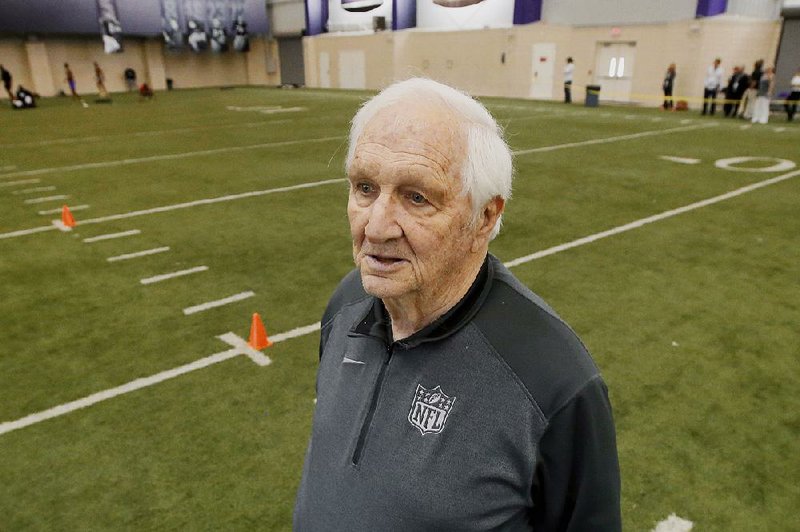Gil Brandt admits he's eager to settle into Chicago this week for the NFL draft, intrigued as much as anybody by the pomp and circumstance exploding around downtown.
There's the mini-city Draft Town that has blossomed in Grant Park. Giant NFL helmets are being showcased along Michigan Avenue. The waters at iconic Buckingham Fountain will be coordinated to light up with the colors of whichever team is on the clock.
The draft, Brandt knows, has become a super-twister of excitement and hype. And as the event roots down in Chicago for the first time in 51 years, Brandt appreciates how much the show has evolved.
"You can't believe how far things have come," he said.
Brandt was in attendance the last time the draft was in Chicago, then a 30-year-old head scout for the Dallas Cowboys, in the early days of his three-decade run as the organization's vice president of player personnel. That 1964 draft actually was conducted in December of 1963 during an era in which college players were drafted before the NFL's season was complete.
There were fewer teams (14) back then and far more rounds (20). Brandt paints the picture of a ballroom at the Sheraton-Chicago hotel, hazed in cigar and cigarette smoke with 14 tables spread around and a fraternity of talent evaluators and decision makers just trying to get their picks right. On a Monday.
Oh, and with no television presence, there was no time limit between picks with teams free to overanalyze and filibuster all they wanted.
That would help explain why the Chicago Tribune chronicled the first three rounds of the '64 draft as consuming 14 hours and 46 minutes. And on things went, right through the night. Round 20 ended at 6:47 a.m.
Harry Hulmes, then the public relations director for the Baltimore Colts before he later became the assistant general manager of the New York Giants, marvels when thinking back on a draft with no time limits.
"They'd wake you up in the conference room during the night to tell you it was your turn to pick," said Hulmes, now 86 and retired in New Jersey. "And it was, 'Oh. OK. Thanks. What round is it anyway? And who else has been drafted ahead of us?' "
Brandt has a deeper explanation for his team's role in the 1964 delay. Early in the second round, with the Cowboys preparing to make the 17th overall pick, the organization had zeroed in on a cornerback from Oregon. Only word had spread that Mel Renfro was still dealing with a hand injury, possibly a severed nerve, as Brandt remembers it, from putting his hand through a mirror after he learned of the death of President Kennedy.
How best to mitigate such an injury risk? The Cowboys summoned a doctor in Portland, requesting he drive to the Oregon campus in Eugene to fully examine Renfro.
"Held the draft up for five hours," Brandt said. "Honestly. Everybody in the room was wanting to throw rocks at us."
It's no wonder then that the draft room was littered with cigarette butts and coffee cups and Coke cans. And with the scouting process far less sophisticated, every team's table, Brandt recalls, had a copy of Street & Smith's College Football Yearbook plus rolls upon rolls of quarters to be fed into the nearest pay phones.
Said Brandt: "You'd have a team needing an offensive tackle. So they might call 'Pappy' Lewis, the coach at West Virginia University and say 'Hey Pappy, who was the best tackle you played against this year? Who should we draft?' "
With George Halas at the helm as both owner and head coach, the Bears made Tennessee offensive tackle Dick Evey their top pick in the 1964 draft and later scooped up a group of players with names too old-timey to be made up: Sid Blanks and Larry Rakestraw, Bob Horton and Cloyd Webb.
Hulmes remembers the passion with which Halas operated, at that time leading a '63 Bears team that went on to win the NFL championship.
"Halas was a firebrand," Hulmes said. "And his acumen about the game was truly impressive."
Brandt's Cowboys, meanwhile, had a field day in the '64 draft, nabbing three players who went on to make the Hall of Fame. In addition to landing Renfro, they also scooped up receiver Bob Hayes in the seventh round and, yes, quarterback Roger Staubach. In Round 10. (Take that, Tom Brady.)
There was one other twist. The AFL was still alive and had held its own draft -- eight teams, 26 rounds -- the previous week. So it was common for college standouts to be drafted twice. Which led to Wild West negotiating tactics with teams in both leagues playing tug-of-war with certain players.
The media coverage of everything, meanwhile, remained minimal. At the '64 event, Brandt remembers a half-dozen newspaper writers attending, including the Tribune's Cooper Rollow.
Compare that to this year's expected media tsunami with more than 1,300 credentials being issued.
Said Brandt: "It's grown from what was essentially a one-story motel in some remote town in Montana into the Sears Tower. And it's still growing. It is totally unbelievable."
Sports on 04/28/2015

